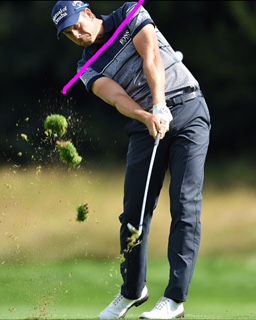What your shoulders do in the golf swing is of utmost importance in making consistent and solid contact with the ball. If you slice the ball, this understanding of the job of the shoulders may help you.
Your shoulders turn on a different angle than your hips. If I was standing straight up and down, and turned my shoulders and hips, they turn on horizontal plane. However, in a golf swing, your are bent from your hips, so your hips and shoulders are no longer horizontal with the ground. From you address position, your shoulders rotate on the same plane throughout your swing. If you lift up your arms in the backswing – instead of keeping your left arm connected with your shoulder turn — you will come out of your shoulder angle, resulting in a loss of power and a tendency to “come over the top” with your arms on the downswing and slice the ball. Remember your shoulders return to square to the ball/target line at impact, not open or closed. A good feel and visual is to take your golf stance and hold a club behind your shoulders and turn back and through. You will see that on that backswing your front shoulder (the one closet to the target) is under your chin, at impact both your shoulders are square at the ball, and in the follow through your back shoulder is under your chin and staying under until after impact – SEE PIC BELOW). Your shoulders turn on a fixed axis which is your spine. Its like the letter T, not straight up and down but tilted over. The top of the letter T are your shoulders. The T line going down is your spine. Notice Henrik Stenson on the left keeps his shoulders turning on the same angle he had at address and backswing, and you can see here how he has kept his shoulders turning on that consistent plane into his follow through. If you are a slicer, your shoulders at his point in this picture would have come out of its plane/angle and your left shoulder would be spinning out to the left of your target with your arms and club following that path. So try making your swing and keeping your shoulder plane/angle consistent from address through to a finish. Any questions, you are free to please contact me!


